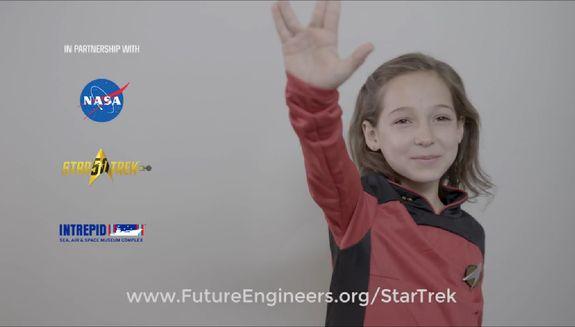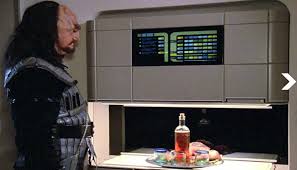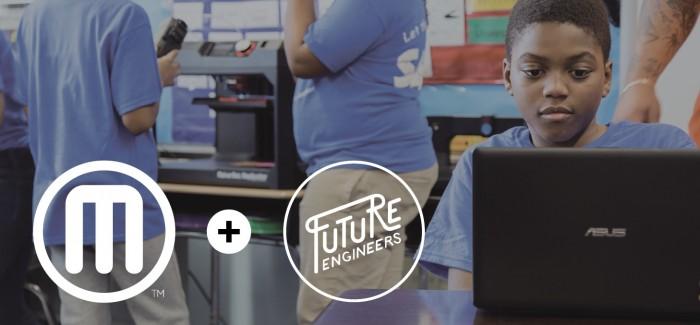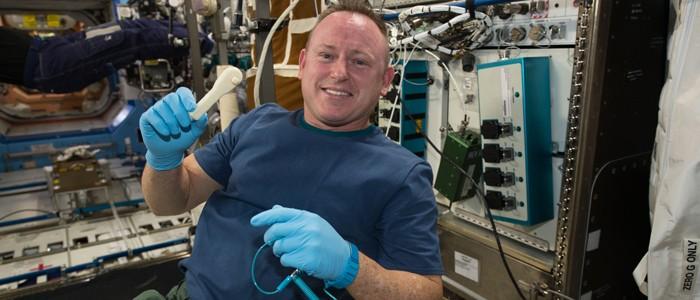It’s 2050: What’s for Dinner on Mars? Help Decide & Enter Your 3D Model in the Star Trek Replicator Challenge!
 How many of you remember whiling away luxurious moments in front of the television during early evenings or on weekends, watching re-runs of Star Trek? What an incredible escape, traveling through the adventures of space with the charismatic crew and imagining your own self using all their incredible devices that took them where they wanted to go and gave them what they requested in an instant. While the original series ended way back in 1969, it’s lived on almost as a culture of its own, kept alive by movies, spin-off shows, and enthusiasts who put the ‘fan’ in fanatical at times.
How many of you remember whiling away luxurious moments in front of the television during early evenings or on weekends, watching re-runs of Star Trek? What an incredible escape, traveling through the adventures of space with the charismatic crew and imagining your own self using all their incredible devices that took them where they wanted to go and gave them what they requested in an instant. While the original series ended way back in 1969, it’s lived on almost as a culture of its own, kept alive by movies, spin-off shows, and enthusiasts who put the ‘fan’ in fanatical at times.
As the epitome of conjuring up what ‘space age’ meant, offering a tantalizing and constant focus on the inventions of tomorrow, the TV series captured many viewers who probably did not even see themselves as having a big interest in science, much less intense concepts in physics. Today, that’s often the case with 3D printing too, which in its compelling futuristic technology invokes great curiosity and the urge to get involved no matter one’s intellectual interests previously.
 MakerBot certainly also had a fun and clever idea in naming their popular machine the Replicator—allowing another enormous nod to the show, as well as to the magic of 3D printing itself. Now, MakerBot and Future Engineers for the ASME Foundation, NASA, and Star Trek are all keeping excitement and challenge alive in the name of science, technology—and space travel. With the Star Trek Replicator Challenge, students K-12 are asked not to think of another 3D printed food item but rather to design new ways to help those traveling in space make and consume victuals.
MakerBot certainly also had a fun and clever idea in naming their popular machine the Replicator—allowing another enormous nod to the show, as well as to the magic of 3D printing itself. Now, MakerBot and Future Engineers for the ASME Foundation, NASA, and Star Trek are all keeping excitement and challenge alive in the name of science, technology—and space travel. With the Star Trek Replicator Challenge, students K-12 are asked not to think of another 3D printed food item but rather to design new ways to help those traveling in space make and consume victuals.
“Over the 50 year lifespan of the Star Trek franchise we have seen countless ways that science fiction has inspired science fact, both in consumer technology and in space exploration,” said Deanne Bell, CEO of Future Engineers. “Now that NASA is 3D printing on the ISS, we thought it was the perfect time to bring Star Trek, NASA and ASME together to educate students about 3D printing in space. MakerBot has played a major role in making 3D printers accessible to students and educators. It’s very apropos to be awarding Replicator Mini 3D printers to the winners’ schools. We’re thrilled to have them on board.”
We’ve been following this challenge since it was announced in February, and while designers have had some time already to think on their ideas, there is still sufficient time—until May 1st—for you to enter your 3D model. The challenge entails creating a 3D model of a ‘non-edible, food related item’ with the vision of astronauts 3D printing it themselves in 2050 (are you doing the math on how old you will be by then?). While the contest is Star Trek themed, students surely could take away some great ideas from The Martian too, which certainly explored creative engineering for creating sustenance while space. And while we hope our astronauts aren’t struggling to avoid starving to death, the story certainly provides inspiration in ‘space farming.’
“We want students to ‘boldy go where no one has gone before’ with 3D printing, by making designs that help astronauts eat nutritious meals so they can ‘live long and prosper’ in locations beyond the International Space Station. Eating a meal in space involves more than the actual food itself – from growing plants to preparing and eating meals,” states the team from Future Engineers on their site.
 MakerBot will be donating eight Replicator Mini Compact 3D printers to the schools of those who qualify as finalists. That’s a win for all involved, with a highly portable, WiFi-connected machine that can be easily moved depending on classes and projects, allowing students and teachers to create their own creativity centers.
MakerBot will be donating eight Replicator Mini Compact 3D printers to the schools of those who qualify as finalists. That’s a win for all involved, with a highly portable, WiFi-connected machine that can be easily moved depending on classes and projects, allowing students and teachers to create their own creativity centers.
“The Star Trek Replicator Challenge is a great way to get students interested in 3D design and 3D printing,” said Jonathan Jaglom, CEO of MakerBot. “While the Replicator concept from Star Trek is still science fiction, MakerBot Replicator 3D Printers have made 3D printing a reality for thousands of schools around the world. 3D printing helps inspire the innovators of tomorrow by allowing students to come up with an idea and make it real.”
Students should take inspiration from Star Trek in considering what it would be like to go on a long space mission, and design around an appetite for healthy foods and tools that could help make them. With plenty of room for creative energy, broad ideas have been offered up such as hardware that will help in the cultivation of nutritious foods, as well as all that goes with preparing, eating, and disposal.
Astronauts are already famously aware of 3D printing and have taken to it with enthusiasm at the International Space Station, as we’ve followed with great enthusiasm of our own here at 3DPrint.com. According to the team, they have so far, fabricated 21 3D printed tools in space, to include the famous wrench and more. This is obviously just the beginning, but is a clear indicator of how the technology allows for meeting immediate needs while away from the security of Earth, along with being able to save on storage in transit as items can be made later upon demand—with journeys to Mars certainly being in the crosshairs of all these new ideas.
“Sustainability will be a critical aspect of long duration space missions and will require off-planet manufacturing technologies to create all of the items our future astronauts need,” said NASA In-Space Manufacturing Manager, Niki Werkheiser.
Each entry should be submitted in the form of an .stl file, accompanied by an image of the model. Both a title and description must accompany it. The entry must be 100% 3D printable, and can be part of a larger project as well. It must be part of a solid geometry, with a size no larger than 6″ x 6″ x 6”. There are many more details to pore over, so if you are entering, be sure to read the Rules Summary and Design Guidelines. Beginners are, however, very much encouraged to enter, and not to get too bogged down by details and guidelines:
“We understand that making a 3D model is tough for beginners! We encourage participation first and foremost, so don’t forget that a great Space Food Object Idea is worth more points during judging than an expertly crafted 3D model. (But having both will score big!) You won’t be disqualified if you submit a model that doesn’t comply with every guideline below, so if you’re a beginner don’t fret if this seems overwhelming,” states the Future Engineers team, regarding the contest guidelines.
Calls for entries end on May 1st, with finalists being named throughout June, and winners announced on July 5th. Prizes are as follows:
- Winners for each age level will travel to New York City for a viewing of the Space Shuttle Enterprise with an astronaut and the Starfleet Academy experience at the Intrepid Sea, Air, & Space Museum. They will also receive a mystery Star Trek prize pack.
- Four finalists, for each age group, will score a win for their schools, with a 3D printer being donated to each one. They will also each win their own PancakeBot!
- Ten semifinalists will win a 3D Printing in Space Prize Pack courtesy of NASA & Made In Space.
For those of us who waved goodbye and marched off with our high school diplomas in hand long ago, this certainly sparks envy, imagining all the lucky students who can immerse themselves in the joy of science fiction and then merge it with the reality of how far we’ve come with space travel and technology by entering a 3D model in this contest.
Here lies the chance to have a small hand in what might be happening as far off as 2050, keeping in mind that while the producers of Star Trek never took time out on the show to explain to us how their inventions were engineered, we can provide far more than just a fictional snapshot of technology today. The thriving community of makers worldwide is a testament to that, and we look forward to seeing what the student population offers up here—as well as hoping we are still conscious and kicking in 2050 to see the future of space travel and how 3D printing plays a part. Any great ideas? Discuss in the Star Trek Replicator Challenge forum over at 3DPB.com.
Subscribe to Our Email Newsletter
Stay up-to-date on all the latest news from the 3D printing industry and receive information and offers from third party vendors.
You May Also Like
3D Printing News Briefs, June 29, 2024: AI Machine Learning, Sensory Garden, Hard Hats, & More
In 3D Printing News Briefs today, we’re starting with Desktop Metal’s new PureSinter furnace. Then it’s on to research about a variable binder amount algorithm and adaptive slicing, a 3D...
Continuum’s New CEO Discusses Launch of Powder as a Service for 3D Printing
Continuum Powders, previously known as MolyWorks Material Corporation, has rebranded and appointed Rob Higby as its new Chief Executive Officer. Higby takes over from Phil Ward, who will now serve...
America Makes Announces $2.1M in Funding for 3D Printing Research
The America Makes Open Project Call 2024 is now open for submissions. The Office of the Under Secretary of Defense, Research and Engineering Manufacturing Technology Office (OSD (R&E)), is providing...
Apple Watch to Use Mass 3D Printed Metal Parts from China’s Bright Laser Technologies
Apple analyst Ming-Chi Kuo has updated the world on the state of Apple’s adoption of additive manufacturing (AM) technology. In a recent blog post discussing Series 10 form factor upgrades...
































